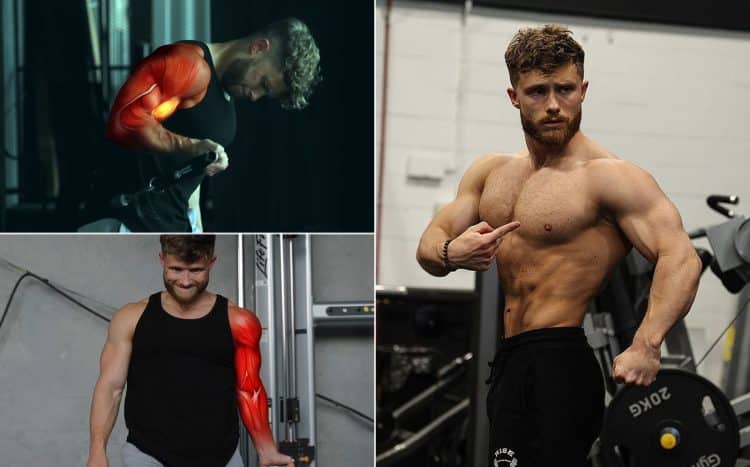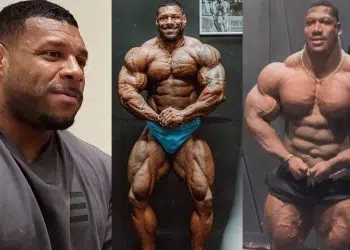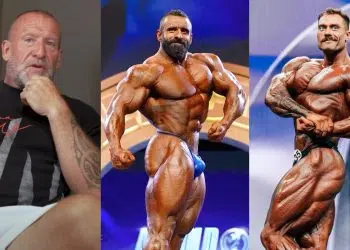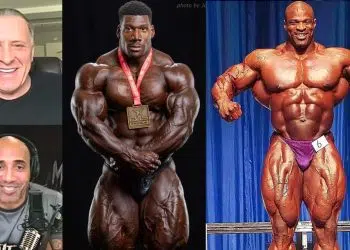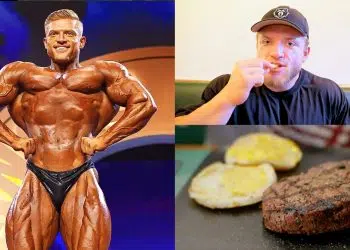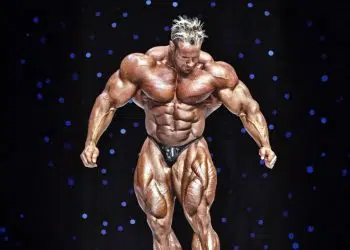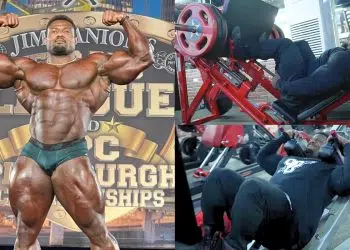Jeff Nippard recently explained the most effective training methods for those willing to work purely for muscle growth. Muscle building is an essential component of fitness training and Nippard’s well-researched guide may help a lot of people achieve their bodybuilding goals.
Canadian fitness influencer Jeff Nippard is a natural bodybuilder, powerlifter and trainer. He has become one of the foremost figures in the science-based YouTube fitness community with illuminating and research-backed fitness content.
But apart from the knowledge and an ability to communicate the ideas with ease, Nippard stands out for his achievements in the fitness industry. He won the 2012 Junior Mr. Canada title in bodybuilding and claimed the 2014 WNBF Natural Muscle Mayhem overall championship.
Nippard did exceptionally well in powerlifting as well and achieved massive lifts like the 502 lbs squat, 336 lbs bench press and a 518 lbs deadlift. Over the years, the Canadian has trained several natural bodybuilders and powerlifters to achieve their goals.
In recent months, Jeff Nippard has dedicated a lot of time in educating the YouTube fitness community about the minimalist training approach and the push–pull–leg workout series inspired by it. Additionally, he took a deep dive into the world of PEDs and highlighted the impact that steroids can have on fitness training as well as other areas of life.
How to train for pure muscle growth – Jeff Nippard explains
In the most recent video posted on his YouTube channel, Jeff Nippard spoke about various methods to boost muscle growth. It is never a good idea to focus on one aspect of training. Most experts, including Jeff Nippard, would advise working on complete development in terms of functional strength, cardio, muscle gain, to name a few.
Level Up Your Fitness: Join our 💪 strong community in Fitness Volt Newsletter. Get daily inspiration, expert-backed workouts, nutrition tips, the latest in strength sports, and the support you need to reach your goals. Subscribe for free!
But for those willing to focus solely on muscle growth, Jeff Nippard shared an incredible plan of action that would guide them in the right direction. So without further delay, let’s check out Jeff Nippard’s five most important criteria to induce hypertrophy and achieve muscle growth.
#1. Tension is king
In simple words, tension is the force that the muscles experience when they stretch and contract under the load. It has been universally accepted as the primary factor that drives muscle growth in training. According to Jeff Nippard:
“Tension causes a biochemical signalling cascade that ultimately tells the muscle it needs to grow bigger.”
As a result, Maximising the tension on muscles should be the goal to build muscle and get big. Nippard then discussed the rest of the training principles that laid out the methods to increase the amount of tension as well as the time under tension.
#2. Using bodybuilding technique
Most people perceive training as a universal phenomenon that serves the purpose irrespective of the end goal. But that’s not quite the case. Training methods change drastically as per the goals and the sport or activity that you are involved in. For instance, a powerlifter’s goal is to move as much weight from point A to point B as possible. Meanwhile, a martial artist’s goal is to build explosive strength and generate massive amounts of force through the movements.
Similarly, a bodybuilder’s end goal is to achieve muscle hypertrophy and subsequent growth. Therefore it is essential to adapt the bodybuilding technique for training to build muscle. This technique is a combination of three simple criteria:
A) Lifting Tempo
Going through the exercise mechanically as it it is a chore wold probably not yield the best results. Nippard said:
“For bodybuilding, you generally want a controlled two to four seconds negative if you’re just used to just letting the weight free fall.”
He cited research that suggests the eccentric (negative) phase of the rep is likely more important for muscle growth than the concentric (positive) phase.
“Most people just try to get the weight up and then forget about lowering it back down. Especially as they get tired toward the end of the set. But this is a mistake because the reps towards the end of a set are the most hypertrophic and the negative is the most important part of each rep.”
For best results, slow negative reps have to be coupled with explosive positive reps.
B) Range of motion
This criteria applies to lifters at all stages of development. Performing every rep with a full range of motion is of utmost importance to stretch and contract the target muscles to the fullest and subject them to maximal tension.
To put in perspective, full range of motion when applied to squats means getting the thighs at least parallel to the ground after lowering down. Similarly, the full range of motion in chest press means lowering the dumbbells or machine handles down enough to feel a good stretch in the pectoral muscles. These are some examples to give an idea about ‘full range of motion’ and it has to be applied for all the exercises.
While this is generally the best practice, partial reps have their place in the training routine as well. Nippard elaborated more on this and said:
“Partial reps are sometimes more effective but only when they’re done in the stretched aspect of the lift. In other words, the stretched part is more hypertrophic than the squeezed part.”
C) Minimal momentum
While a little bit of momentum is at play during most exercises, relying on it too much can actually stop the muscle growth as it does not get the necessary tension required to induce hypertrophy. Maintaining a strict form without momentum is an essential component of bodybuilding. By default, this is the third and final criteria of the bodybuilding technique.
#3. Efforts
No matter how scientifically accurate your training program, exercise sequence or technique is, it is simply not possible to achieve muscle growth if you don’t work hard enough to induce hypertrophic effects.
“Unfortunately, research consistently shows that most people simply don’t push their sets hard enough to maximize muscle growth.”
This is one of the leading causes of suoptimal growth. So it is essential to give careful thought to whether you have achieved the natural potential or is it simply that you are not training hard enough to break the plateau.
“As you get closer and closer to failure, the more muscle growth you tend to see,” Nippard stated.
Get Fitter, FasterLevel Up Your Fitness: Join our 💪 strong community in Fitness Volt Newsletter. Get daily inspiration, expert-backed workouts, nutrition tips, the latest in strength sports, and the support you need to reach your goals. Subscribe for free!
Multiple studies back this claim but there are several others that don’t align with this conclusion. Through his experience, Nippard has been able to find a solution to this issue. He advices:
“Do two to three sets on most exercises and take the last set all the way to failure. For the first one or two sets, leave one or two reps in the tank. If you were to go to failure for all the sets, you’d most likely be fatigued by the last set. Which means you’d get less reps and hit less volume as a result.”
Personally, Jeff Nippard stops a couple of reps shy of failure even in the last set for compound exercises like deadlifts, bench press and squats. Going to failure is far too fatiguing when you’re training heavy and stopping short of failure helps Nippard finish the rest of the workout without compromising on strength, technique and form.
#4. Give muscles a reason to grow
Challenging the body’s current capabilities and pushing the boundary a little bit every day is the proven way of getting bigger and stronger.
“To keep the muscles progressing, you need to apply the progressive overload principle where you need to increase some training variables from week to week,” Nippard said.
There are several different ways of applying progressive overload principle to your training routine. The Canadian fitness expert advices employing the following:
A) Adding reps to the same amount of weight
Adding reps to the same amount of weight over a period of four weeks and repeating the cycle with increased weight is one of the ways of applying progressive overload. According to Jeff Nippard, this type of overloading is better for moderate to high rep ranges.
An example of this is:
- 1st Week – 1 set of 10 reps
- 2nd Week – 1 set of 11 reps
- 3rd Week – 1 set of 12 reps
- 4th Week – 1 set of 13 reps
- 5th Week – 1 set of 10 reps with extra weight (repeat the cycle with this new weight from sixth week onwards)
B) Adding weight to the same number of reps
This method of progressive overload is similar to the previous method. However, the roles reverse between weight and reps. By keeping the same number of reps week after week, you have to use incrementally heavier weights to load the muscles. Contrary to the previous, this type of progressive overload is usually better for low to moderate rep range.
C) Improve some aspect of your technique and improving mind-muscle connection
The third idea is to make positive changes to lifting technique like controlling the negative rep, using less momentum on the positive rep or simply improving the range of motion.
“I still count this as progressive overload because it increases tension on the target muscles,” Jeff Nippard said.
D) Build mind-muscle connection
Building mind-muscle connection is extremely important to understand your own body and adapt best practices for its growth. Nippard referred to studies that show mind-muscle connection has a great impact on hypertrophy.
#5. Choose high tension exercises
Nippard reiterates that the principles explained in this session are purely for hypertrophy purposes. They do not have anything to do with strength gain. You can gain strength and muscle using only a few compound exercises like squats, deadlifts, bench press, pull-ups and rows. However, it is not the best route for maximising muscle growth. Why? Here’s Jeff Nippard’s explanation:
“Two reasons… One, there will be smaller muscles that go under stimulated if this is literally all you do. Muscles like the biceps, side delts, hamstrings and calves won’t be getting enough love. Secondly, some of these exercises don’t have the best stimulus to fatigue ratio.”
Simply put, the stimulus to fatigue ratio is the ratio between the tension the exercise delivers to the target muscles and how fatiguing the exercise is for the muscle to recover from it. It does not mean that exercises that cause high fatigue are not worth doing. But when hypertrophy is the only goal for training, movements that give high stimulus and cause less fatigue are the best bet.
“Machine and cable based exercises are the best options for this. They provide massive tension for less fatigue than free weights and also tend to be safer to take to failure.”
Machines are every bit as effective as free weights for hypertrophy
As per the studies that Jeff Nippard referred for this video, machines are at least as effective as free weights for muscle hypertrophy. According to some other studies, they even surpass the stimulus provided by free weights.
“Machines and cables tend to have fantastic resistance profiles where you get the smooth, even tension throughout the range of motion,” Nippard added.
As we all know by now, cable machines put the muscles under tension throughout the range of motion unlike free weights. This makes them a superior alternative for hypertrophy training.
“Free weights have some advantages too. They are more accessible, they tend to have better strength carryover and they may activate smaller stabilizers better. I’m still a fan of the barbell. I think that strength can fit neatly into a hypertrophy plan if programmed correctly. If we’re designing the program purely dedicated for muscle growth, that’s a recovery wrinkle we don’t need to worry about.”
Other factors like exercise split, rest periods and specialized hypertrophy techniques like drop sets and supersets can also contribute significantly to work for muscle gain.
Jeff Nippard’s advise is for hypertrophy focused training. Head out to the gym today and combine it with your strength training routine to see the results!
Watch full video below, courtesy of Jeff Nippard’s personal YouTube channel:

